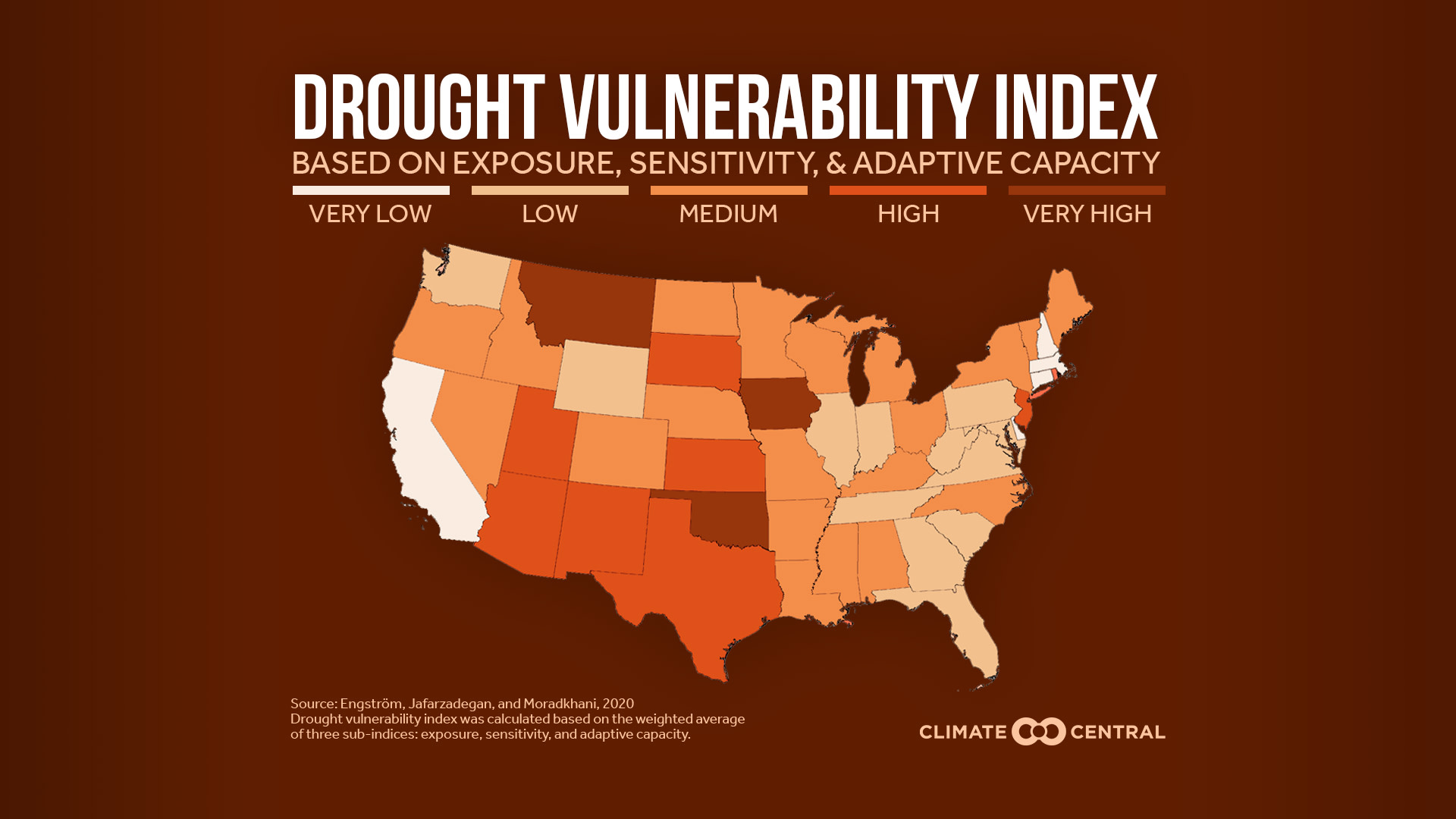KEY CONCEPTS
Drought is one of the costliest disasters in the U.S., causing 94 deaths and an inflation-adjusted $6.2 billion in losses per year on average since 1980.
While we often think of states in the western U.S. being most at risk of drought (based on the frequency and severity of drought there), a recent study modelled drought vulnerability defined as exposure and sensitivity to drought, as well as ability to adapt.
In this study, researchers found that states ranking highest in overall vulnerability often had less to do with how frequently drought occurs, and more with how prepared the state is for drought impacts.
Drought will continue to worsen in a warming world. However, there are adaptive strategies states can undertake to significantly reduce their vulnerability to its impacts.
According to the U.S. Drought Monitor, 39% of the U.S. land area is currently experiencing moderate to exceptional drought that is affecting more than 74 million people, particularly across the West and Northeast. Recently, NOAA’s Climate Prediction Center predicted that southern parts of the U.S. may experience expanded and intensifying drought during the winter months ahead, due to the La Nina climate pattern. While drought is a complex event that is brought about by a variety of factors, we do know that climate change exacerbates drought conditions where they occur—making them more persistent and more intense.
Rising temperatures increase the rate of evaporation, drying out soils as well as adding moisture to the atmosphere and changing precipitation patterns. This gives rise to an intensification of the water cycle which, simply put, is making wet places wetter and dry places drier. Drought is one of the costliest disasters in the U.S., causing an average of 94 deaths and an inflation-adjusted $6.2 billion in losses per year since 1980.
There are different ways to think about vulnerability to weather and climate events. A recent study considered drought vulnerability as being driven by three factors: exposure, sensitivity and adaptive capacity. The study defined:
Exposure - the frequency of drought, the state’s population, and the freshwater ecosystems that could be affected
Sensitivity - a state’s likelihood of being negatively impacted by drought, taking into account industries such as agriculture, water recreation and hydropower
Adaptive capacity - a state’s preparedness for drought and ability to recover, looking at the state’s drought plan, irrigation infrastructure and economic strength
In this study, researchers found that states ranking highest in overall vulnerability often had less to do with how frequently drought occurs, and more with how prepared the state is for drought impacts. For instance, Oklahoma was ranked as the most vulnerable state due largely to its extensive cattle ranching and other agricultural enterprises, as well as limited possibilities for irrigation. Two other midwestern states, Iowa and South Dakota, made the top five most vulnerable list, in addition to Montana and Arizona.
A low vulnerability score does not mean a state is not (or will not) experience drought conditions. California, often one of the first states that comes to peoples' minds when they think of drought, has one of the lowest vulnerability scores. This is due to California’s relatively strong economy and robust adaptation measures, which make it more resilient than other states with more limited adaptive capacity.
The Northeast was considered a less vulnerable region as a whole, with a few notable exceptions. High population densities and an abundance of protected freshwater ecosystems contributed to high exposure scores for New Jersey and New York. In addition to protected waters, Maine’s hydropower and water recreation industries make the state more susceptible to adverse economic impacts in the event of a drought.
By assessing these three categories, this study helps states identify what makes their state vulnerable to drought, to help inform addressing drought in the future.
You can find more information and resources on drought and climate change here:
POTENTIAL LOCAL STORY ANGLES
Is my area experiencing drought?
Search your city or zipcode at Drought.gov to find out if your area is experiencing drought.
What impacts does drought have in my community?
Drought impacts really vary by region. The 2018 National Climate Assessment summarizes examples of water sector sensitivities by region. The National Drought Mitigation Center (NDMC), powered by the University of Nebraska, maintains an interactive Drought Impact Reporter map where you can observe drought impacts by location and type. Check out a map from the U.S. Department of Agriculture (USDA) to see where drought designated as ‘disasters’ occurred this year. The USDA also provides maps of where drought areas coincide with important crop regions.
What measures are being taken to cope with drought?
The NDMC provides a database of drought management measures taken across the U.S., which can be searchable by sector (e.g. farming, energy and tourism). It also maintains a register of drought, hazard and water plans by state, accompanied by local drought experts and agencies.
LOCAL EXPERTS
The NDMC maintains a database of contact information for drought experts by state. The SciLine service, 500 Women Scientists or the press offices of local universities may be able to connect you with local scientists who have expertise on drought in your area. The American Association of State Climatologists is a professional scientific organization composed of all 50 state climatologists. You can also contact experts at your Regional Climate Center, a program under NOAA’s National Center for Environmental Information (NCEI).
NATIONAL EXPERTS
Johanna Engstrom, Assistant Professor of Meteorology
Applied Aviation Sciences Department at Embry-Riddle Aeronautical University
(previously a postdoctoral researcher at the University of Alabama’s Center for Complex Hydrosystems Research)
johanna.engstrom@erau.edu
Hamid Moradkhani, Director for the Center for Complex Hydrosystems Research and Alton N. Scott Professor of Civil and Environmental Engineering at the University of Alabama
Corresponding Author
College of Engineering at The University of Alabama
hmoradkhani@ua.edu
METHODOLOGY
Drought vulnerability index data for the contiguous United States was obtained from Engström, Jafarzadegan, and Moradkhani, 2020.
